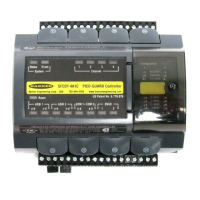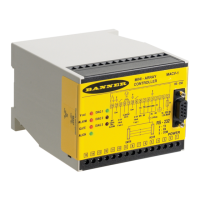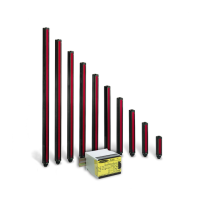8.3.4 Uploading or Downloading Configuration Files
The DXM700 requires a XML configuration file to become operational. To upload or download configuration files, connect a
computer to the DXM700 using the USB port or Ethernet port. Then use the Upload Configuration to Device or Download
Configuration from Device under the Device menu.
8.4 EtherNet/IP
™
Configuration
The DXM700 is defined from the factory to send/receive register data from the Gateway and the first 16 Nodes with an
EtherNet/IP
™
1
host.
To expand the number devices going to Ethernet/IP, change the Devices in system parameter in the DX80 Gateway
(default setting is 8) to 32. To change this value:
1. Launch the the DX80 Configuration Software.
2. In the menu bar, go to Device > Connection Settings and select Serial or Ethernet DXM.
3. In the Configuration > Device Configuration screen, click on the arrow next to the Gateway to expand and display
the Gateway's parameters.
4. In the System section, use the Devices in system drop-down list to make your selection.
This allows the user to maximize the use of the EtherNet/IP buffer to 28 devices.
EDS (Electronic Data Sheet) files allow users of the EtherNet/IP protocol to easily add a Banner DXM device to the PLC.
Download the EDS files from the Banner website.
• DXM EDS Configuration File (for PLCs) (p/n b_4205242)
• DXM EIP Config File for DXM Controller with Internal Gateway (Models: DXM1xx-BxR1, DXM1xx-BxR3, and
DXM1xx-BxCxR1) (p/n 194730)
8.4.1
Configuring the Host PLC
On the host PLC, install the DXM700 using an EDS file or by using the following parameters:
• Assembly1: Originator to DXM = Instance 112, 456 bytes (228 words)
• Assembly2: DXM to Originator = Instance 100, 456 bytes (228 words)
The Originator is the host PLC system, and the DXM is the DXM700. The host system sees the DXM700 as a generic device
with the product name of Banner DXM (ProdType: 43 - Generic Device, ProdName: Banner DXM).
Important: Do not set the Requested Packet Interval (RPI) any faster than 150 ms.
8.4.2 Configuring the Controller
Use the DXM Configuration Software to define the Protocol conversion for each local register to be EIP Originator -> DXM
or EIP DXM -> Originator from the Edit Register or Modify Multiple Register screens.
• Define a DXM local register as EIP Originator -> DXM when the host PLC (Originator) will send data to the DXM700
local register (DXM).
• Define a DXM local register as EIP DXM -> Originator when that register data will be sent from the DXM700 (DXM)
to the host PLC (Originator).
Data from an EIP controller in assembly instance 112 is data destined for the DXM700 local registers. The first two bytes of
the assembly instance are stored in the first local register defined as an EIP Originator -> DXM register. The next two bytes
of the assembly instance are stored in the next local register defined as an EIP Originator -> DXM register. For example, if
DXM local registers 5, 12, 13, and 15 are configured as EIP Originator -> DXM, the first eight bytes (four words) of data from
the assembly instance are stored into these registers in order (5, 12, 13, and 15). The system ignores the rest of the bytes in
the assembly instance.
Data from the DXM700 local registers is sent to the EIP controller using assembly instance 100. Each local register in the
DXM700 defined as EIP DXM -> Originator is collected in numerical order and placed into the data buffer destined for
assembly instance 100. DXM local registers are capable of 32-bits, but only the lower 2-bytes for each local register are
transferred. For example, if DXM registers 1, 10, 20, and 21 are defined as EIP DXM -> Originator registers, the assembly
instance 100 will have the first eight bytes of data coming from the DXM local registers 1, 10, 20, and 21. The rest of the data
is in assembly instance 100 is zero.
For example, define register 1 as an EIP Originator -> DXM (target) register. The EIP PLC will write data into register 1. For
local registers to be sent to the EIP controller, define registers as EIP DXM -> Originator. Use the Modify Multiple
Registers screen to change many registers parameters at one time.
The DXM700 is big endian: the upper bits of a local register (15:8) are stored in the first byte of the assembly instance and
the second byte of the assembly instance is stored in the lower bits of a local register (7:0).
1
EttherNet/IP is a trademark of Rockwell Automation.
Sure Cross
®
DXM700-Bx Wireless Controller
www.bannerengineering.com - Tel: + 1 888 373 6767 51
